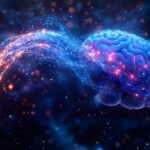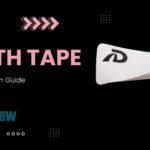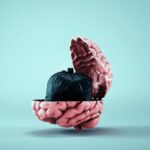How cutting-edge research uses AI and machine learning to correlate multiple factors for a more robust understanding of sleep health.
By Ann H. Carlson
Many sleep issues are multifactorial, but artificial intelligence (AI) and machine learning models in sleep medicine have mostly been limited to inputs from a single data source. However the trend of multimodal AI—AI trained to identify patterns between different data inputs, for example, polysomnography (PSG) results and socioeconomic data—is starting to put sleep into its real-world contexts.
“By addressing complex problems that may not be easily detectable with single-mode information, like just pulse or oxygen levels, multimodal AI can deliver more accurate diagnoses and treatment plans,” says Mikael Kågebäck, PhD, chief technology officer at sleep wellness app and smart alarm clock Sleep Cycle.
These discoveries can also lead to sleep testing, tracking, and screening tools incorporating multiple AI modalities for more targeted treatments.
Several recent multimodal AI studies have delivered surprising discoveries that will influence the future of sleep medicine. Here are just a few.
Predicting the Spread of Disease
Millions of people in more than 150 countries use the sleep-tracking app Sleep Cycle, which has collected more than 2 billion nights’ worth of data from consenting customers since its launch in 2009. “With access to vast sleep data from around the world, we’re empowered to address questions that were previously unanswerable,” Kågebäck says.
For example, in the summer of 2023, Sleep Cycle conducted a study geolocating the number of coughing events with the reported cases of COVID-19 in the United States. Its Cough Radar tool tracks how many times a user coughs per hour, as well as changes to their coughing pattern, using sound analysis and machine learning. Researchers could see elevated coughing patterns even before people sought testing or treatment.
“Based on an increase in coughing events, we were able to predict the wave of illness two weeks before the cases were officially reported,” Kågebäck says. The study also revealed local patterns of disease within larger cities as well as clear seasonal patterns.
“The ability to track how sickness spreads via coughing data allows us to have a better understanding and will hopefully help us better cope with illness outbreaks in the future,” Kågebäck says.
For multimodal AI research, Sleep Cycle relies on internally collected data and the broader research landscape in sleep medicine.
“To improve our sleep-tracking capabilities, we undertook a significant project to develop robust breathing tracking,” Kågebäck says. “We integrated this data with movement data and trained our sleep-staging model to predict hypnograms produced by PSG, the gold standard in sleep research. This resulted in much more precise audio-based sleep staging.”
Through its customer base, Sleep Cycle receives short audio clips that cover events such as breathing, snoring, movement, and speech.
“Our team of annotators meticulously labels these events, contributing to a comprehensive dataset comprising over 300 different classes,” Kågebäck says.
Conducting studies with a large number of subjects is complicated, which is why Kågebäck emphasizes a research-based approach.
“When dealing with complex datasets with many factors, it’s important not to jump to conclusions based solely on apparent correlations,” Kågebäck says. “It’s crucial to ensure that correlations are backed by solid research and evidence before moving forward.”
Sleep Cycle is now exploring partnership opportunities with universities and other stakeholders to assess how coughing data can contribute to early warning systems for disease outbreaks.
Practical Pediatric Sleep Apnea Testing
Collecting sleep data from children at home poses several challenges, which means home sleep apnea testing is much less prevalent for pediatric patients than adults. In a recent study, Rahmatollah Beheshti, PhD, an assistant professor at the University of Delaware, and his team used machine learning to explore methods to help detect sleep apnea more easily at home in children.
“One key barrier to running sleep apnea testing outside the clinic for children is the presence of noise and missingness, as children can move more frequently, be less cooperative, and pull the probes, among other issues,” Beheshti says.
Collecting large-scale sleep data—especially for pediatric patients—is often the first hurdle. “AI models are really data-hungry, and access to sleep data (even consumer-level and not lab quality) is hard due to various challenges, such as privacy issues,” Beheshti notes.
For this study, the research team used information from PSG data collected in controlled laboratory studies. A machine learning-based model was used to detect apnea events in children from commonly collected sleep signals, including electrocardiogram (ECG), electroencephalogram (EEG), electrooculogram, oxygen saturation (SpO2), carbon dioxide, and respiratory signals.
It split the signals into epochs gathered from different sources (for example, data derived from PSG and patients’ electronic health records) from which the machine learned. “To make our studies closer to outside-clinic scenarios, we have also injected various types of manual noise into the data,” Beheshti says.
The study showed that even without EEG, detecting apnea in children with high accuracy may be doable using advanced AI algorithms. “This was to some degree even surprising to our team, as EEG is generally considered as the most clinically important signal for children,” Beheshti says.
“We also observed that using two of the signals that are easier to collect at home (ECG and SpO2) can also achieve very competitive results compared to using all six or seven modalities. This can potentially address the concerns about collecting various sleep signals from children outside the clinic.”
The hope is these findings will help increase access to pediatric sleep testing. “The most evident usage could be helping patients and families make more informed decisions, especially by helping them consult with clinical experts at the right time,” Beheshti says.
Promoting Equity in Health Care
Three recent multimodal health data studies published by EnsoData—makers of the AI-based EnsoSleep sleep-scoring platform—concentrate on the socioeconomic factors that may affect obstructive sleep apnea (OSA) diagnosis and treatment. For example, they found that less than 50% of patients in the least advantaged areas start therapy after being diagnosed with OSA.
“By identifying and better understanding gaps in access to OSA care, we can create opportunities to help address and close those gaps,” says Chris Fernandez, EnsoData’s chief research officer. “This requires clinical tools, tests, and treatments that are inclusive and accessible for patients regardless of race, gender, age, levels of income, or location.”
Based on the records of more than 6 million patients, these studies linked claims data, diagnostic records, and medication information with socioeconomic measures, including the Area-Deprivation Index mapping tool that displays the relative socioeconomic condition of specific neighborhoods. The studies also included demographic factors, such as race, gender, and age, and examined treatment and income disparities.
“We believe social determinants of health variables should be part of the validation of any AI/machine learning models proposed for population health applications,” Fernandez says.
Fernandez notes that AI is already helping sleep medicine move toward precision care by simplifying testing for patients, helping to scale the diagnostic process for physicians, and identifying patients who are struggling with CPAP.
“Leveraging multimodal biomedical AI models in the analysis of sleep studies has the potential to transform our understanding of sleep health and disorders and their broader role and influence on health risks and the length and quality of life,” Fernandez says.
Illustration 141540838 © Jozsef Bagota | Dreamstime.com








